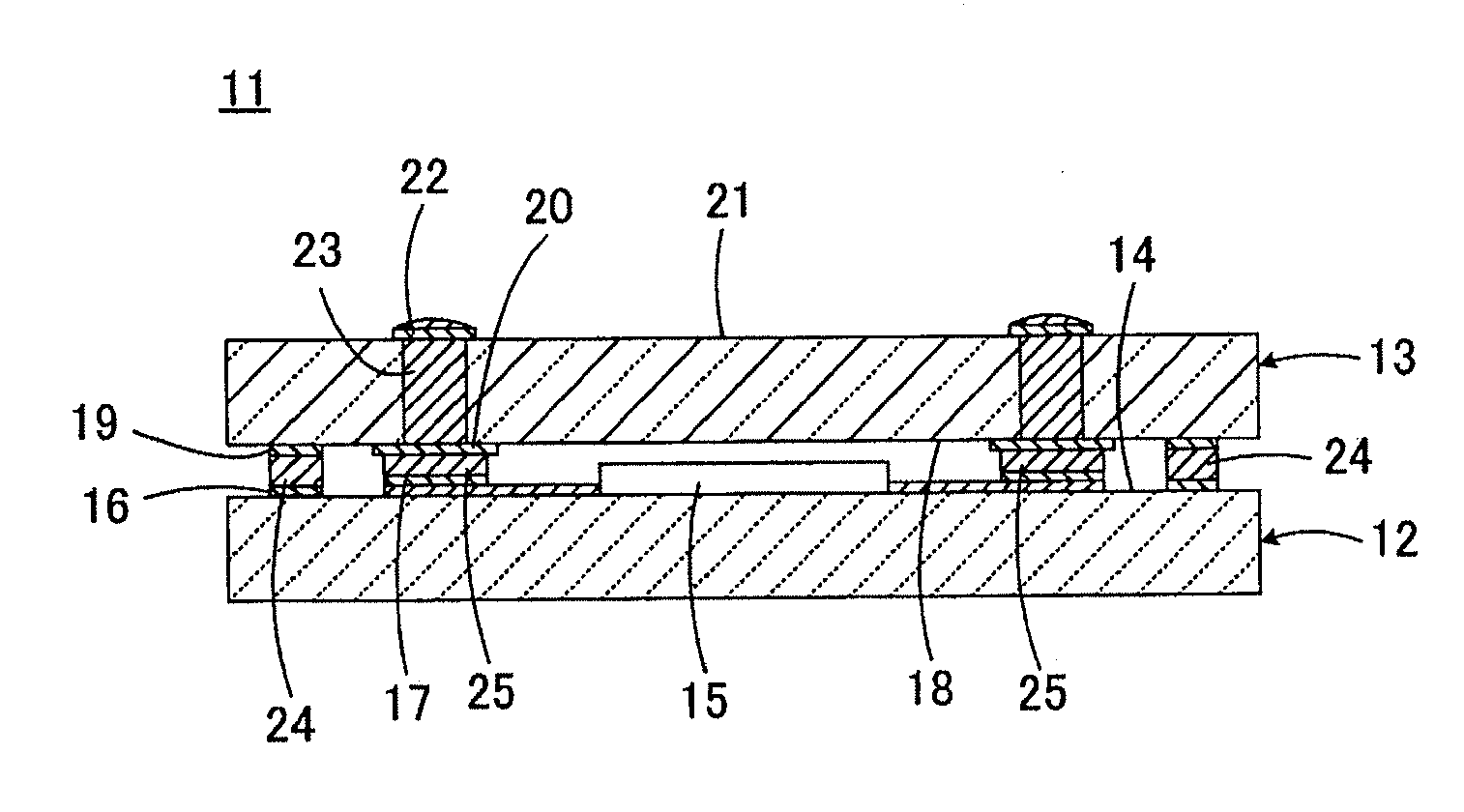Electronic Component Device and Method for Manufacturing the Same
a technology of electronic components and manufacturing methods, applied in the direction of coupling device connections, electrical apparatus casings/cabinets/drawers, soldering apparatus, etc., can solve the problems of high production cost, low productivity, and quality degradation, and achieve rapid growth rate, reduce production cost, and form in a short time
- Summary
- Abstract
- Description
- Claims
- Application Information
AI Technical Summary
Benefits of technology
Problems solved by technology
Method used
Image
Examples
first embodiment
[0057]FIG. 2 is a view for illustrating the present invention and shows an enlarged view of a part of the first sealing frame 16 and a part of the second sealing frame 19 in FIG. 1. FIG. 2(1) shows a pre-bonding state and FIG. 2(2) shows a post-bonding state of the first sealing frame 16 and the second sealing frame 19.
[0058]With reference to FIG. 2(1), both of the first sealing frame 16 and the second sealing frame 19 are composed of a Ni film predominantly composed of Ni. Each of the widths of the first and second sealing frames 16 and 19 is, for example, 50 μm. In addition, in order to enhance adhesion between the Ni film and each of the main substrate 12 and the cover substrate 13, a Ti film, but not shown, may be formed between the Ni film and the main substrate 12 and between the Ni film and the cover substrate 13.
[0059]A Bi layer 26 predominantly composed of Bi is formed on the first sealing frame 16. On the other hand, an Au layer 27 predominantly composed of Au is formed on...
second embodiment
[0071]FIG. 3 is a view corresponding to FIG. 2 for illustrating the present invention. In FIG. 3, the same reference symbols are given to elements corresponding to the elements shown in FIG. 2, and overlapped descriptions are omitted.
[0072]The second embodiment has a feature that the Au layer 27, which is smaller in thickness than that in the first embodiment, is formed to avoid the formation of an Au2Bi layer at the bonding section 24. That is, the thickness of the Au layer 27 is determined in such a way that a volume of Au supplied from the Au layer 27 is 11.1% of a volume of Bi supplied from the Bi layer 26. As an example, when the thickness of the Bi layer 26 is 5 μm, the thickness of the Au layer 27 is 0.55 μ. Consequently, as shown in FIG. 3(2), only a ternary alloy layer 29 predominantly composed of a Ni—Bi—Au ternary alloy is formed at the bonding section 24 as a result of the heating and bonding step.
third embodiment
[0073]FIG. 4 is a view corresponding to FIG. 2 for illustrating the present invention. In FIG. 4, the same reference symbols are given to elements corresponding to the elements shown in FIG. 2, and overlapped descriptions are omitted.
[0074]The third embodiment has a feature that the Au layer 27, which is larger in thickness than that in the first embodiment, is formed to avoid the formation of a ternary alloy layer predominantly composed of a Ni—Bi—Au ternary alloy at the bonding section 24. That is, the thickness of the Au layer 27 is determined in such a way that a volume of Au supplied from the Au layer 27 is 27% or more of a volume of Bi supplied from the Bi layer 26. As an example, when the thickness of the Bi layer 26 is 5 μm, the thickness of the Au layer 27 is 1.35 μm or more. By setting the thickness of the Au layer 27 like this, as shown in FIG. 4(2), only an Au2Bi layer 30 is formed at the bonding section 24 in performing the heating and bonding step.
[0075]In addition, wh...
PUM
| Property | Measurement | Unit |
|---|---|---|
| melting point | aaaaa | aaaaa |
| melting point | aaaaa | aaaaa |
| temperature | aaaaa | aaaaa |
Abstract
Description
Claims
Application Information
 Login to View More
Login to View More - R&D
- Intellectual Property
- Life Sciences
- Materials
- Tech Scout
- Unparalleled Data Quality
- Higher Quality Content
- 60% Fewer Hallucinations
Browse by: Latest US Patents, China's latest patents, Technical Efficacy Thesaurus, Application Domain, Technology Topic, Popular Technical Reports.
© 2025 PatSnap. All rights reserved.Legal|Privacy policy|Modern Slavery Act Transparency Statement|Sitemap|About US| Contact US: help@patsnap.com



